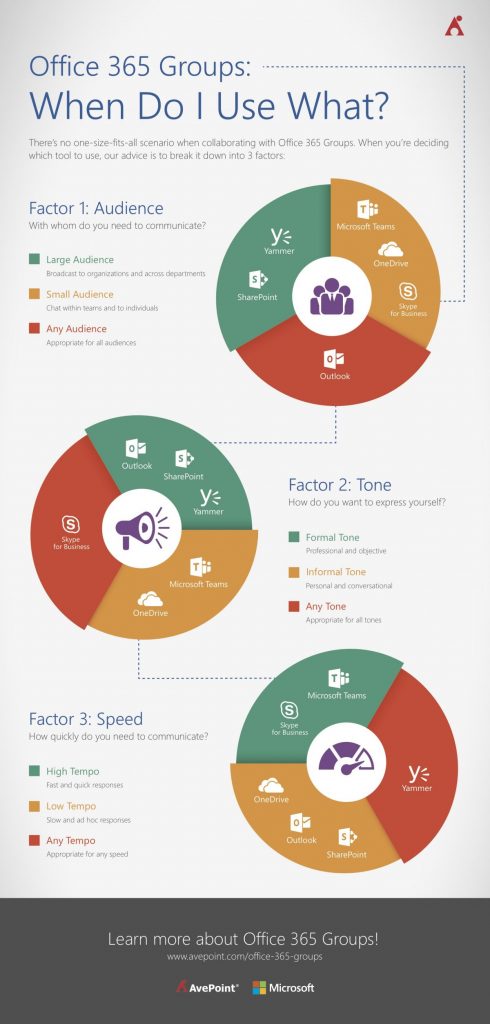Want to learn more about collaborating in Office 365? Click here to download our free Office 365 Groups Playbook!
I recently attended several Teams Governance Workshops held by AvePoint in multiple U.S. cities. Based on customer feedback, it’s apparent that Teams is on the minds of most organizations. However, it’s also important to recognize that the challenges of Microsoft Teams and Office 365 are no different than previous versions of SharePoint. When we polled customers about their most pressing concerns with Office 365, they replied with 3 significant challenges:
- How do I ensure adoption?
- How do I control adoption without crippling my users’ ability to collaborate?
- How do I avoid risk and sprawl on this new platform?

As I mentioned in my previous blog post, organizations and users are already confused as to where they should be collaborating. This will only increase once new technologies are deployed.
How can organizations get ahead of the curve and ensure that this deployment will be the one that changes the way their business works? Being in the SharePoint space for over 12 years, there are a few basic tricks that I’ve seen make it easier for business users to collaborate.
Identify User Challenges
It seems like such a simple thing, right? I’m sure most of you reading this are already saying “We do this with every new technology we implement,” and I’m sure that’s the case. If this is being done, though, why do we continue to see email and chat used as the primary methods of communication in our organizations?
I’ve seen the largest challenges arise for those of us who work in technology ourselves. We want to show the business user a better way without taking the time to understand the issues with what they’re using today.

Based on research conducted by Daniel Kahneman and Amos Tversky (above), culminating in Kahneman’s Nobel Prize in 2002, a user will often need to realize a perceived gain of at least 3x to change their way of working (anything less would be viewed as “losing” what they already have).
So, how can this be addressed in the real world? While there’s no silver bullet, the best place to start is by reaching out to select business users and asking the right questions. I’ve seen a few common scenarios resonate with customers across all verticals while at AvePoint:
- Can you easily find the data you work with on a daily basis? (A great trick here is to ask them to find a document that should be readily accessible to everyone in their business unit).
- How many places do you currently store your data today?
- Which platforms do you log into to collaborate on a daily basis?
- How many channels do you need to work with to stay on top of company updates?
Outside of the questions above, what’s worked best is to identify the line of business (LOB)-specific tasks that users perform regularly. Once we know that, we can ask what’s most frustrating about their process and start working towards a solution.
Associate Business Value and Impact to Those Challenges
The next step would be to understand how much those challenges impact the business. Keep in mind that a user needs a perceived value increase of 3x over an existing solution to make a change. This is where it’s important to not only understand the challenge, but also the context of that challenge.
Let’s take the example from previous exercise of a user describing how they locate a specific document. Say the process went something like this:
- The user searches their inbox for the subject line of an email they remember containing an important link.
- Unfortunately, that subject line search produces hundreds of emails. The user then move onto their initial file share of choice.
- A similar document is found there, but it’s dated at over 3 years old.
- The user then messages a colleague for the latest version because they saw that colleague using it a week ago.
- The colleague emails an attachment to the user.

How could the user distinguish between the newer/older versions of that document six months down the line? Let’s say the user worked for a manufacturing company. What’s the potential impact of them working with outdated design documents?
And that’s just one example of a user’s perspective. Think of companies with thousands of users. The challenges of maintaining an inefficient collaboration platform can include things such as:
- Increased cost of maintaining multiple platforms with similar functionality
- Increased risk due to data residing in unsecured repositories
- Decreased productivity due to duplication, outdated, and limited visibility of the data running core business processes each day
A better way to collaborate is by harnessing the power of technology while increasing the bottom line for your business.

Choose the Right Platform (Office 365)
At this point we should be able to make the case for change. You might be asking, “What platform should we change to?” As a Microsoft Partner there may be some bias, but more often than not I’ve seen Office 365 as the only platform that meets a wide range of required functionality.
One of the simplest formats that can be used to justify technology adoption was presented by John T. Gourville of the Harvard Business Review here. He refers to this as The Trade-Offs Innovation Demand. Users should identify the proposed “innovation” and then outline the gains and losses of implementing it. Evaluating each platform like this will give you a good idea as to what your best option will be.

Define a Process to Eliminate Confusion
Now you’ve decided on your platform (for argument’s sake, let’s assume its Office 365). How do you ensure that your users are actually adopting it and utilizing the platform effectively? With offerings from Exchange, SharePoint, Teams, Groups, Yammer, etc. it can be daunting for a non-technical person to know where to go.
Creating a table that outlines the intended collaboration methods can be a big help. Be sure to consider audience, formality, and sensitivity as your starting points. From there you can add anything your company in particular may require.
For more in-depth information on “When to Use What” check out this whitepaper and this webinar!
The best way to make this easy for your users is through automation. Automation will allow them to answer business-related questions more easily and enjoy a corresponding digital workspace for their need.

This can be done through workflows developed in-house or through third parties such as AvePoint. The benefit of utilizing AvePoint is that we drastically reduce the time it takes to deploy products. We also provide the added advantage of automation throughout the lifecycle of any digital workspace. This addresses many of the challenges uncovered in the chart above.
There is no easy way to solve all the challenges your organization may face when implementing new technology, especially in the enterprise collaboration space. However, the path to adoption can be a smooth one if you can accurately pair technical features with their appropriate business uses. I hope I’ve provided you with a starting point to making your next major technology shift a lasting one!
Like what you read? Be sure to subscribe to our blog for all things Office 365 and more.





